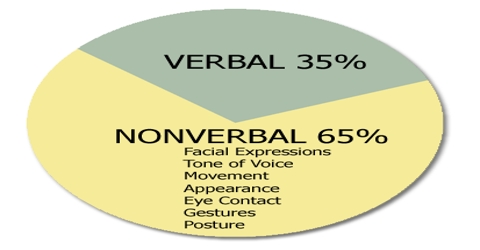Nature / Features of Non-verbal Communication
Non-verbal communication is a type of communication that does not use any oral or written word. It can communicate some human feelings more accurately than those of other methods of communication. Some important features of this communication are discussed below:
- No use of Words
Non-verbal communication occurs without using any written or oral word. It is communication without words or language like oral or written communication. Instead of writes or oral words, it relies on various non-verbal cues like physical movement, tasks, colors, signs, symbols, signals charts, etc. to express human feelings, attitudes and information. It uses gestures, facial expressions, eye contact, physical propinquity, etc. for communicating with others.
- Different meanings
Non-verbal symbols can numerous meanings. A single message of non-verbal communication may express different meaning to different persons or in different places. The symbols and signs that we used as the media of non-verbal communication are not always accurate in expressing the true meaning of the communication. Cross-culture aspects give diverse meanings to similar expression in admiration of this communication. In many cases, they are vague and inconsistent. So the media of non-verbal communication should be used carefully.
- Pervasiveness
Non-verbal communication is pervasive in nature. If we look around us, we can see the numerous aspects of non-verbal communication. This communication is unconscious in the sense that it is generally not intended nor rehearsed. It comes approximately instantly. Now we need to learn how to observe and detect them. Murphy and his associates mentioned that 60% to 70% effect of the message comes from non-verbal cues.
- Vague and imprecise
Non-verbal communication is fairly blurred and imprecise. Since in this communication, there is no use of words or language which expresses clear denotation to the receiver. Facial expressions, gestures, body engagements, the method you use your eyes – all communicate your feelings and emotions to others. How you stand or sit is one of the important elements in how you are perceived by others. For example, we all know someone who “talks with his hands.”
- Culturally determined:
Non-verbal communication is learned in the early days, passed on to you by your parents and others with whom you associate. Through this procedure of growing up in an exacting civilization, you espouse the taints and mannerisms of your cultural group.
Application: Verbal communication is primarily associated with face-to-face oral communication as we can readily observe the non-verbal symbols there. Besides this, written communication can also be analyzed on the basis of its non-verbal parts. For example, the format, neatness, and language of a written message communicate a non-verbal message to the readers.















